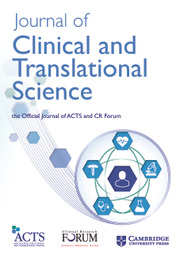No CrossRef data available.
Article contents
68 Bridging research and practice: Investigating barriers and facilitators in the translational journey of transcranial magnetic stimulation
Published online by Cambridge University Press: 11 April 2025
Abstract
Objectives/Goals: This systematic review aims to identify and synthesize evidence on the barriers and facilitators impacting the implementation of transcranial magnetic stimulation (TMS) in clinical practice, enhancing understanding for improved adoption and efficacy. Methods/Study Population: This systematic review follows PRISMA guidelines to identify relevant literature on barriers and facilitators to TMS in North America. We conducted a comprehensive search of databases including PubMed, Scopus, and PsycINFO, targeting studies published from 2000 onward. Eligible studies include qualitative and quantitative research focusing on adults aged 18 years and older in the USA and Canada. Two independent reviewers screened titles, abstracts, and full texts, extracting data on barriers and facilitators related to TMS implementation. Results/Anticipated Results: We anticipate identifying a diverse range of barriers and facilitators related to TMS implementation in North America. Expected barriers may include limited clinician knowledge, patient resistance, and logistical challenges in clinical settings. Facilitators could encompass supportive institutional policies, clinician training, and positive patient outcomes. The synthesis of findings will highlight key themes, guiding future research and practice. We aim to produce actionable recommendations for stakeholders, ultimately enhancing the effective integration of TMS in clinical care for adult populations. Discussion/Significance of Impact: This review will provide crucial insights into the barriers and facilitators of TMS implementation, informing clinicians, policymakers, and researchers. By highlighting actionable strategies, it aims to enhance TMS accessibility and efficacy, ultimately improving patient outcomes and advancing neurotherapeutic practices in North America.
Information
- Type
- Biostatistics, Epidemiology, and Research Design
- Information
- Creative Commons
- This is an Open Access article, distributed under the terms of the Creative Commons Attribution-NonCommercial-NoDerivatives licence (https://creativecommons.org/licenses/by-nc-nd/4.0/), which permits non-commercial re-use, distribution, and reproduction in any medium, provided the original work is unaltered and is properly cited. The written permission of Cambridge University Press must be obtained for commercial re-use or in order to create a derivative work.
- Copyright
- © The Author(s), 2025. The Association for Clinical and Translational Science

